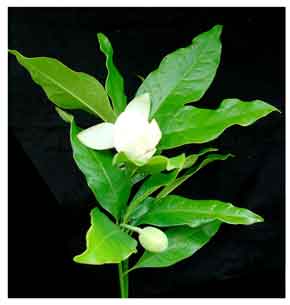|  General
info General
info
Magnolia is an ancient genus. By the end of the 18th
century, Magnolia species were described in China and Japan. The first
Asiatic species were M. denudata, M. lilliflora, M. coco, and M. figo.
Its bark has long been used in traditional Chinese medicine where it
is called houpu.
Magnolia is a common name and large genus group of about 210 trees and shrubs in the flowering plant family Magnoliaceae, characterized by aromatic twigs and large showy flowers. It has an ecologically symbiotic relationship with beetle pollinators, providing nutrition and the benefit of pollination. (9)
 Botany Botany
Magnolia coco is a medium-sized shrub or a small tree growing to 3 meters. Leaves
are smooth alternate, acuminate, elliptic-oblong, up to 16 centimeters long,
dark green above, and waxy pale green below. Flowers are single, nodding, rounded like an egg or baby coconut, opening up with
6 white fragrant petals. Unlike most magnolias lacking nectar, Magnolia coco secretes a nectar-like substance inside the flower.
Distribution
- Planted but not common in the Philippines.
- Propagated by seeds or marcotting.
- Considered an excellent indoor plant.
- Native to China.
Constituents
• The aromatic bark contains
magnolol and honokiol, polyphenolic compounds that have antianxiety
and anti-angiogenic properties.
• Study on leaves yielded a new compound (N-acetylanolobine), among eighteen compounds including fourteen lignans, one coumarin,
and three alkaloids. (3)
• Study of leaves yielded a new amide, magnolamide and a new lignan, magnolone,
and 11 known compounds as follows: episesamin, sesamin, magnolol, fargesin, aschantin, epieudesmin, syringaresinol, syringaresinol-O-beta-D-glucopyroside, scoparone, oxoanolobine, and dicentrinone. (4)
• Study of chemical constituents of essential oil isolated fifty-six compounds comprising 87.46% of the total essential oils. The principle components were α-pinene, nerolidol, caryophyllene, germacrene D, bicyclogermacrene. (6)
• Studies of secondary metabolites have yielded
alkaloids from the bark i.e., liriodenine, magnoflorine, salicifoline, anolobine, stephanine, and magnococline; and from the leaves, N-acetylanolobine, dicentrinone, and oxoanolobine. (10)
• Study of leaves yielded a new amide, magnolamide (1), and a new lignan, magnolone (2), along with 11 known compounds i.e., episesamin, sesamin, magnolol, fargesin, aschantin, epieudesmin, syringaresinol, syringaresinol-O-ß-D-glucopyroside, scoparone, oxoanolobine, and dicentrinone. (12)
• Study of flowers isolated five known polyphenols i.e., kobusin (1), (+)-sesamin (2), epicatechin (3), chlorogenic acid (4), and rutin (5). (see study below) (13)
• Study of methanol and n-hexane solvents yielded 2.9% and 39.10% yield on extraction.
Qualitative analysis of methanol extract yielded tannins, phenolic, saponin, and terpenoid, while the n-hexane extract only yielded a terpenoid compound. GC-MS analysis of n-hexane extract yielded six constituents i.e., 1,5-Octadiene-3,7-diol; 3,7-dimethyl- (terpenediol I) (1); 2,6-Dimethyl-1,7-octadiene-3,6-diol (2); 3,5,5-trimethyl-4-(3-oxobutyl)-1-cyclohex-2-enone (3); 3,7-dimethyl-4-(2-methyl-1-propenyl)-2,4,5,6,7,7a-hexahydro-1H-inden-1-ol (4), (S)-4,5,9,9-Tetramethyl- 2,4a,5,6,7,8,9,9a-octahydro-1H-1,5-cyclo-benzocycloheptene (5), and 3-(3-Butynyl)-2-cycloocten-1- valerenol (6). (14)
Properties
• Unlike most magnolias, M. coco secretes a nectar-like substance inside the flower.
Parts utilized
Bark, flowers, leaves.
Uses
Edibility / Culinary
- Flowers added to tea to enhance the fragrance.
Folkloric
- No reported folkloric medicinal use in the Philippines
-
Used in Japanese and Chinese
traditional medicine.
- In China, floral buds used for headache and stomachache.
- Used for insomnia, leucorrhea, productive coughing.
- Bark used for allergic and asthmatic conditions.
- Magnolia bark extracts also reported to inhibit bacteria responsible
for dental caries and periodontal disease.
Studies
• LDL Oxidation Inhibition: Inhibition of low density lipoprotein oxidation by tetrahydrofurofuran
lignans from Forsythia suspensa and Magnolia coco.
• Phytochemicals / New Constituents: Study yielded a new amide, magnolamide and a new lignan, magnolone with eleven known compounds from the leaves of Magnolia coco. (4)
• Oral Hygiene Component: Magnolia bark extract in combination with a surface active agent is a component of a chewable oral composition with cleansing, breath freshening and antimicrobial benefits. (Patent pending)
• Essential Oil Constituents: The principal constituents of essential oils in M. coco from Guangxi are α-pinene, nerolidol, caryophyllene, germacrene D, bicyclogermacrene. (6)
• Antioxidant Activity / Tetrahydrofurofuran Lignans / Stems: Major antioxidants were identified from the fruits of Forsythia suspensa and stems of Magnolia coco. Of the bioactive tetrahydrofurofuran lignans, pinoresinol, phillygenin, and syringaresinol were found to be more potent than probucol. They were shown to exhibit antioxidant activity due to inhibition of oxidation of low-density lipoproteins (LDL). (8)
• DPPH Free Radical Scavenging / Flowers: Study evaluated methanol, ethyl acetate, and n-hexane solvent extracts for antioxidant activity using DPPH free radical scavenging activity. Results showed concentration dependent antioxidant activity with the methanol extract showing highest antioxidant activity at 4,138 µg/mL. The ethyl acetate and n-hexane extracts showed no antioxidant activity. (11)
• Anti-Glycation / Polyphenols / Flowers: Study investigated various plant extracts from flowers of Magnolia coco for inhibitory effects on advanced glycation end-products formation. Study isolated procyanidine oligomer and four other compounds from the flowers. Results showed significant inhibition of AGE formation. The procyanidin oligomer (6) showed remarkable inhibitory effect on AGE formation. Compound 3, epicatechin, exhibited significant AGE-derived crosslink-cleaving activity. Results suggest a potential for the flowers to play a role in prevent of age-related processes and diseases and/or an anti-skin aging cosmeceutical. (see constituents above) (13)
Availability
Wild-crafted. |


 General
info
General
info Botany
Botany

